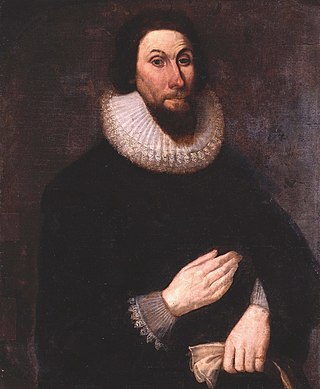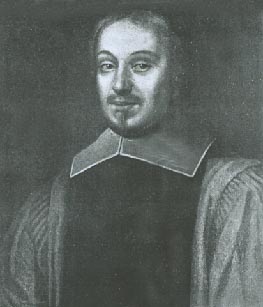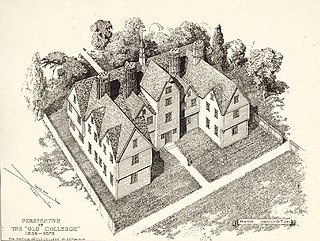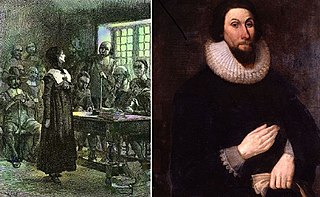
Roger Williams was an English-born New England Puritan minister, theologian, and author who founded Providence Plantations, which became the Colony of Rhode Island and Providence Plantations and later the State of Rhode Island. He was a staunch advocate for religious freedom, separation of church and state, and fair dealings with the Native Americans.

John Winthrop was an English Puritan lawyer and one of the leading figures in founding the Massachusetts Bay Colony, the second major settlement in New England following Plymouth Colony. Winthrop led the first large wave of colonists from England in 1630 and served as governor for 12 of the colony's first 20 years. His writings and vision of the colony as a Puritan "city upon a hill" dominated New England colonial development, influencing the governments and religions of neighboring colonies in addition to those of Massachusetts.

The Massachusetts Bay Colony (1628–1691), more formally the Colony of Massachusetts Bay, was an English settlement on the east coast of North America around the Massachusetts Bay, one of the several colonies later reorganized as the Province of Massachusetts Bay. The lands of the settlement were in southern New England, with initial settlements on two natural harbors and surrounding land about 15.4 miles (24.8 km) apart—the areas around Salem and Boston, north of the previously established Plymouth Colony. The territory nominally administered by the Massachusetts Bay Colony covered much of central New England, including portions of Massachusetts, Maine, New Hampshire, and Connecticut.

Anne Hutchinson was a Puritan spiritual advisor, religious reformer, and an important participant in the Antinomian Controversy which shook the infant Massachusetts Bay Colony from 1636 to 1638. Her strong religious convictions were at odds with the established Puritan clergy in the Boston area and her popularity and charisma helped create a theological schism that threatened the Puritan religious community in New England. She was eventually tried and convicted, then banished from the colony with many of her supporters.

Thomas Dudley was a New England colonial magistrate who served several terms as governor of the Massachusetts Bay Colony. Dudley was the chief founder of Newtowne, later Cambridge, Massachusetts, and built the town's first home. He provided land and funds to establish the Roxbury Latin School and signed Harvard College's new charter during his 1650 term as governor. Dudley was a devout Puritan who opposed religious views not conforming with his. In this, he was more rigid than other early Massachusetts leaders like John Winthrop, but less confrontational than John Endecott.

Richard Bellingham was a colonial magistrate, lawyer, and several-time governor of the Massachusetts Bay Colony, and the last surviving signatory of the colonial charter at his death. A wealthy lawyer in Lincolnshire prior to his departure for the New World in 1634, he was a liberal political opponent of the moderate John Winthrop, arguing for expansive views on suffrage and lawmaking, but also religiously somewhat conservative, opposing the efforts of Quakers and Baptists to settle in the colony. He was one of the architects of the Massachusetts Body of Liberties, a document embodying many sentiments also found in the United States Bill of Rights.

Nathaniel Eaton was an Anglican clergyman who was the first Headmaster of Harvard, President designate, and builder of Harvard's first College, Yard, and Library, in 1636.

Mary Dyer was an English and colonial American Puritan-turned-Quaker who was hanged in Boston, Massachusetts Bay Colony, for repeatedly defying a Puritan law banning Quakers from the colony. She is one of the four executed Quakers known as the Boston martyrs.
William Hutchinson (1586–1641) was a judge at Portsmouth in the Colony of Rhode Island and Providence Plantations. He sailed from England to New England in 1634 with his large family. He became a merchant in Boston and served as both Deputy to the General Court and selectman. His wife was Anne Hutchinson who became embroiled in a theological controversy with the Puritan leaders of the Massachusetts Bay Colony which resulted in her banishment in 1638. The Hutchinsons and 18 others departed to form the new settlement of Pocasset on the Narragansett Bay, which was renamed Portsmouth and became one of the original towns in the Rhode Island colony.

The Puritan migration to New England was marked in its effects from 1620 to 1640, declining sharply afterwards. The term Great Migration can refer to the migration in the period of English Puritans to the New England Colonies, starting with Plymouth Colony and Massachusetts Bay Colony. They came in family groups rather than as isolated individuals and were mainly motivated by freedom to practice their beliefs.
The Boston martyrs is the name given in Quaker tradition to the three English members of the Society of Friends, Marmaduke Stephenson, William Robinson and Mary Dyer, and to the Barbadian Friend William Leddra, who were condemned to death and executed by public hanging for their religious beliefs under the legislature of the Massachusetts Bay Colony in 1659, 1660 and 1661. Several other Friends lay under sentence of death at Boston in the same period, but had their punishments commuted to that of being whipped out of the colony from town to town.
Edward Hutchinson (1613–1675) was the oldest child of Massachusetts and Rhode Island magistrate William Hutchinson and his wife, the dissident minister Anne Hutchinson. He is noted for making peace with the authorities following his mother's banishment from the Massachusetts Bay Colony during the Antinomian Controversy, returning to Boston, and ultimately dying in the service of the colony that had treated his family so harshly.

In the early 17th century, thousands of English Puritans settled in North America, almost all in New England. Puritans were intensely devout members of the Church of England who believed that the Church of England was insufficiently reformed, retaining too much of its Roman Catholic doctrinal roots, and who therefore opposed royal ecclesiastical policy. Most Puritans were "non-separating Puritans" who believed there should be an established church and did not advocate setting up separate congregations distinct from the Church of England; these were later called Nonconformists. A small minority of Puritans were "separating Puritans" who advocated setting up congregations outside the Church. The Pilgrims were a Separatist group, and they established the Plymouth Colony in 1620. Puritans went chiefly to New England, but small numbers went to other English colonies up and down the Atlantic.

Robert Pike (1616—1706) was an opponent of the Salem witchcraft prosecutions of 1692. He was also involved in two other notable, public controversies prior to 1692. The first was his open criticism of the persecution of the Quakers, for which he was arraigned by the Massachusetts General Court in 1653. Years later, he became embroiled in a long feud with the pastor of Salisbury, the Reverend John Wheelwright, who excommunicated him in 1675 and was later obliged to reinstate him.
John Humphrey was an English Puritan and an early funder of the English colonisation of North America. He was the treasurer of the Dorchester Company, which established an unsuccessful settlement on Massachusetts Bay in the 1620s, and was deputy governor of the Massachusetts Bay Company from 1629 to 1630. He came to Massachusetts in 1634, where he served as a magistrate and was the first sergeant major general of the Ancient and Honorable Artillery Company. He became involved in English attempts to settle Providencia Island in the late 1630s, and returned to England in 1641 after financial reverses and probable religious differences with other members of the Massachusetts ruling elite. He then became involved in an attempt to settle The Bahamas in the late 1640s, and had some involvement in the politics of the English Civil War.

The Antinomian Controversy, also known as the Free Grace Controversy, was a religious and political conflict in the Massachusetts Bay Colony from 1636 to 1638. It pitted most of the colony's ministers and magistrates against some adherents of Puritan minister John Cotton. The most notable Free Grace advocates, often called "Antinomians", were Anne Hutchinson, her brother-in-law Reverend John Wheelwright, and Massachusetts Bay Governor Henry Vane. The controversy was a theological debate concerning the "covenant of grace" and "covenant of works".

John Wilson was a Puritan clergyman in Boston in the Massachusetts Bay Colony, and the minister of the First Church of Boston from its beginnings in Charlestown in 1630 until his death in 1667. He is most noted for being a minister at odds with Anne Hutchinson during the Antinomian Controversy from 1636 to 1638, and for being an attending minister during the execution of Mary Dyer in 1660.
William Baulston (c.1605—c.1678) was a colonial New England innkeeper who was active in the civil and military affairs of both the Massachusetts Bay Colony and the Colony of Rhode Island and Providence Plantations. He was a founding settler of Portsmouth, Rhode Island, was continuously elected to the highest positions in the colony, and was one of the ten Assistants named in the Rhode Island Royal Charter.
Dorcas ye blackmore was one of the first named African Americans to settle in New England. In 1641, she became the first known African American admitted to the local Puritan congregation.
The murder of Penowanyanquis took place in Plymouth Colony in July 1638. Penowanyanquis, a Native American man who was part of the Nipmuc, was attacked by four runaway indentured servants – Thomas Jackson, Richard Stinnings, Daniel Cross, and their informal leader Arthur Peach, the four sometimes being referred to as the "Peach Gang" – during a botched attempt at highway robbery. Penowanyanquis lived for several days after the attack, long enough to identify his attackers. After the four were arrested, Cross fled before he could be taken to trial and was never relocated, but Stinnings, Jackson, and Peach were all taken into custody, convicted of murder and robbery, and judicially executed in September 1638.